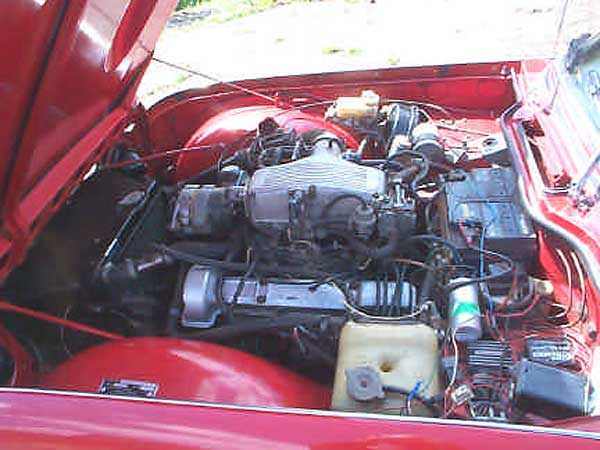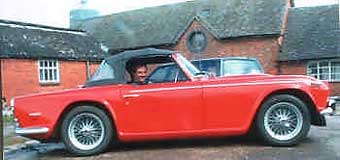�
�
�
�
�
�
� Owner: Neil Brown
� City: Staffordshire, England
� Model: 1968 Triumph TR250
� Engine: Triumph Stag V8
� Conversion completed by: Owner�
� I don't think you can beat the sound or the torque of a V8. The "burble" is fantastic � & is enough to turn most heads even when the car is being driven modestly. Mine � really gets people's attention at speed! The torque from a V8 also makes driving a � pleasure & consequently I wanted to get a V8 into my Triumph TR250. However, I � farm in Staffordshire England and do not have much surplus time. Consequently, my � objective was to find the quickest transplant I could. Like most enthusiasts, at least � in the UK, I first started measuring up an ex Buick 3500/4000cc Rover engine. However, � it quickly became obvious that the gearbox might take some time to fit as might the � exhaust headers. Working forward from the gearbox, which I decided to retain if � possible, a Triumph Stag engine looked overall an easier fit than the Rover.�
� My original TR gearbox was, of course, very little different from the Stag's transmission. � There is a slight complication in that the Stag tranny sits at the back of the Stag's � engine on a slight angle. Consequently the gear lever tends to twist to one side & � requires a compensatory sideways shift. I cut the gearlever off just above the ball, � welded a plate to the now foreshortened top & then re-weld the gear stick to the plate.�
� There isn't a lot of room between the cylinder heads of any V8 & the inner-wings. � However, as I got into more detail I realized that the Stag engine was actually� easier to fit than the Rover since the Stag's cylinder heads have angled (downwards) � exhaust header flanges - which would make it far easier to take the headers away close � to the block. The Rover's cylinder heads have vertical faces to the exhaust flanges � necessitating the pipes loop away from the heads. The final clincher was that I thought � that I would have the barest minimum of bulkhead changes to make, if any at all.�
�
�
�
�
 �
�
Neil Brown's 1968 TR-250 with a Triumph Stag V8 Engine
� as published in British V8 Newsletter, Volume X Issue 3, September 2002�� Owner: Neil Brown
� City: Staffordshire, England
� Model: 1968 Triumph TR250
� Engine: Triumph Stag V8
� Conversion completed by: Owner�
� I don't think you can beat the sound or the torque of a V8. The "burble" is fantastic � & is enough to turn most heads even when the car is being driven modestly. Mine � really gets people's attention at speed! The torque from a V8 also makes driving a � pleasure & consequently I wanted to get a V8 into my Triumph TR250. However, I � farm in Staffordshire England and do not have much surplus time. Consequently, my � objective was to find the quickest transplant I could. Like most enthusiasts, at least � in the UK, I first started measuring up an ex Buick 3500/4000cc Rover engine. However, � it quickly became obvious that the gearbox might take some time to fit as might the � exhaust headers. Working forward from the gearbox, which I decided to retain if � possible, a Triumph Stag engine looked overall an easier fit than the Rover.�
� My original TR gearbox was, of course, very little different from the Stag's transmission. � There is a slight complication in that the Stag tranny sits at the back of the Stag's � engine on a slight angle. Consequently the gear lever tends to twist to one side & � requires a compensatory sideways shift. I cut the gearlever off just above the ball, � welded a plate to the now foreshortened top & then re-weld the gear stick to the plate.�
� There isn't a lot of room between the cylinder heads of any V8 & the inner-wings. � However, as I got into more detail I realized that the Stag engine was actually� easier to fit than the Rover since the Stag's cylinder heads have angled (downwards) � exhaust header flanges - which would make it far easier to take the headers away close � to the block. The Rover's cylinder heads have vertical faces to the exhaust flanges � necessitating the pipes loop away from the heads. The final clincher was that I thought � that I would have the barest minimum of bulkhead changes to make, if any at all.�
�
�
So the Stag appeared to be the easier engine to squeeze in & the 180cu in iron �
block / aluminum heads would be about the same weight as an original Triumph - so I �
decided to give it a go. Nevertheless I had to bias the engine towards the left side �
of the car (by about 1") to give the steering column a little room & still managed �
to get the left-side exhaust header down the side of block with hardly any carving - �
certainly none worth talking about. Moving the engine an inch to the left was not in �
fact the whole story, for the steering rack had to be moved an inch to the right too! �
I made a lower steering column complete with the extra u-joint.�
� The Stag engine is actually shorter (about 1") than the original 6-cylinder unit so I � thought the engine should sit clear of the car's bulkhead. Indeed it does! So what about � the comparative heights? Stag wins again, but not by much. It is about 1" lower than � the Rover V8, which allowed me to close the bonnet/hood without any difficulty even � with the efi induction in place.�
� Anyone interested in Triumph cars has to have heard that the Stag engine's reliability � is questionable. Back in the 1970's the car sadly developed an entirely deserved � reputation for overheating, warped cylinder heads & some doubt as to what car you � would come home in when you left in a Stag! We have some very experienced Stag � specialists in the UK & I visited a number at a Triumph show / meet & was told � the basics as to what I must do to make my unit reliable. I learnt it is very important � to change the engine oil & filter regularly every 3000 miles to give the timing � chains longevity. You will also need to change the timing chains about every 30000 � miles. Sooner if they get noisy earlier than that, which also tells you that you are � not changing the engine oil sufficiently frequently. �
� To help my water pump stay submerged I fitted an enlarged header tank & fitted an � automatic air-bleed from the top of the radiator to the additional header tank on the � advice of the Stag experts.�
� Strangely enough, finding a place for and mounting the alternator was my biggest � challenge. �
� Since I had managed to retain the original gearbox, the original prop-shaft, rear � suspension & drive shafts were hardly changed at all. I fitted hard polyurethane � pivot bushes to the trailing arms & have had no problems there in spite of using � the car every day, rain, shine or snow. However, the extra torque from the V8 is � showing-up the numerous universal joints in my drive train as now being inadequate & � upgraded u-joints are going to be required soon. �
� I swapped the car's original 3.7 ratio rear axle for the slightly "taller" 3.45 one - � which has worked out really well. �
� My initial induction was a Holley 390cfm 4-barrel carburetor, but its flat-spots brought � me to change to an ex-Rover EFI system. I am delighted with this upgrade & feel it � has "made" the car with its balance of good manners & power - depending upon my � right foot!�
� �
�
�
� The Stag engine is actually shorter (about 1") than the original 6-cylinder unit so I � thought the engine should sit clear of the car's bulkhead. Indeed it does! So what about � the comparative heights? Stag wins again, but not by much. It is about 1" lower than � the Rover V8, which allowed me to close the bonnet/hood without any difficulty even � with the efi induction in place.�
� Anyone interested in Triumph cars has to have heard that the Stag engine's reliability � is questionable. Back in the 1970's the car sadly developed an entirely deserved � reputation for overheating, warped cylinder heads & some doubt as to what car you � would come home in when you left in a Stag! We have some very experienced Stag � specialists in the UK & I visited a number at a Triumph show / meet & was told � the basics as to what I must do to make my unit reliable. I learnt it is very important � to change the engine oil & filter regularly every 3000 miles to give the timing � chains longevity. You will also need to change the timing chains about every 30000 � miles. Sooner if they get noisy earlier than that, which also tells you that you are � not changing the engine oil sufficiently frequently. �
� To help my water pump stay submerged I fitted an enlarged header tank & fitted an � automatic air-bleed from the top of the radiator to the additional header tank on the � advice of the Stag experts.�
� Strangely enough, finding a place for and mounting the alternator was my biggest � challenge. �
� Since I had managed to retain the original gearbox, the original prop-shaft, rear � suspension & drive shafts were hardly changed at all. I fitted hard polyurethane � pivot bushes to the trailing arms & have had no problems there in spite of using � the car every day, rain, shine or snow. However, the extra torque from the V8 is � showing-up the numerous universal joints in my drive train as now being inadequate & � upgraded u-joints are going to be required soon. �
� I swapped the car's original 3.7 ratio rear axle for the slightly "taller" 3.45 one - � which has worked out really well. �
� My initial induction was a Holley 390cfm 4-barrel carburetor, but its flat-spots brought � me to change to an ex-Rover EFI system. I am delighted with this upgrade & feel it � has "made" the car with its balance of good manners & power - depending upon my � right foot!�
� �
�
�
�
�
 �
�

